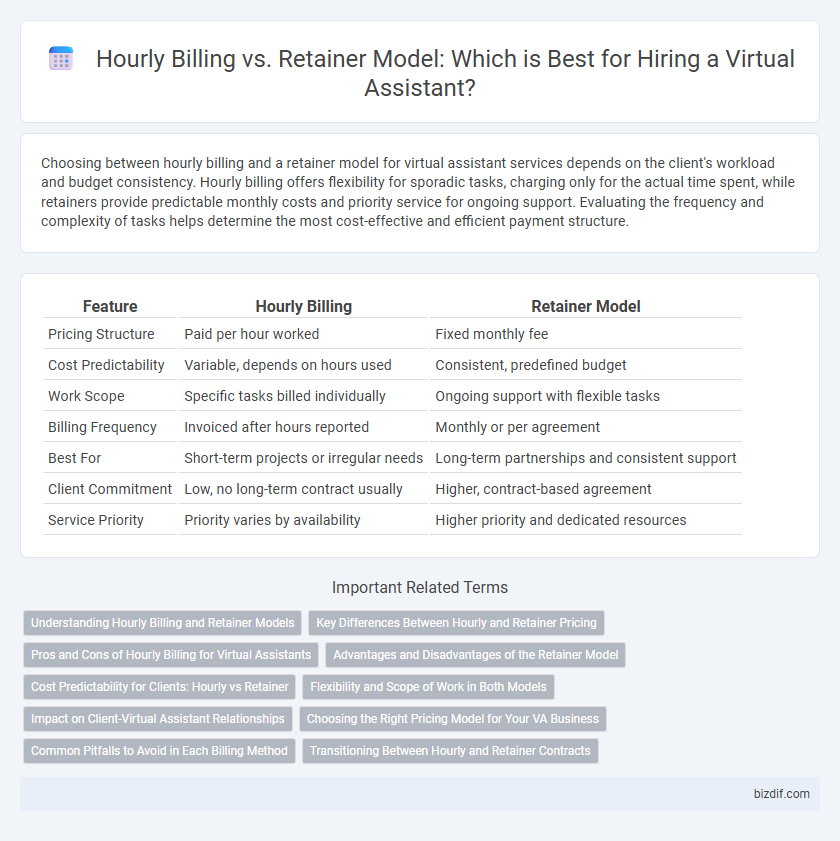Choosing between hourly billing and a retainer model for virtual assistant services depends on the client's workload and budget consistency. Hourly billing offers flexibility for sporadic tasks, charging only for the actual time spent, while retainers provide predictable monthly costs and priority service for ongoing support. Evaluating the frequency and complexity of tasks helps determine the most cost-effective and efficient payment structure.
Table of Comparison
| Feature | Hourly Billing | Retainer Model |
|---|---|---|
| Pricing Structure | Paid per hour worked | Fixed monthly fee |
| Cost Predictability | Variable, depends on hours used | Consistent, predefined budget |
| Work Scope | Specific tasks billed individually | Ongoing support with flexible tasks |
| Billing Frequency | Invoiced after hours reported | Monthly or per agreement |
| Best For | Short-term projects or irregular needs | Long-term partnerships and consistent support |
| Client Commitment | Low, no long-term contract usually | Higher, contract-based agreement |
| Service Priority | Priority varies by availability | Higher priority and dedicated resources |
Understanding Hourly Billing and Retainer Models
Hourly billing charges clients based on the exact time spent completing tasks, making it ideal for projects with variable or unpredictable workloads. The retainer model involves clients paying a fixed fee upfront for a predetermined number of hours or services each month, ensuring consistent support and budget predictability. Virtual assistants often choose retainer agreements to maintain steady workflows and build long-term client relationships while offering flexibility through hourly billing for one-time or irregular tasks.
Key Differences Between Hourly and Retainer Pricing
Hourly billing charges clients based on the actual time spent on tasks, providing flexibility but potential cost unpredictability. Retainer pricing involves a fixed monthly fee for a set scope of services, ensuring consistent support and budget stability. The key differences lie in payment predictability, client commitment, and service prioritization.
Pros and Cons of Hourly Billing for Virtual Assistants
Hourly billing for virtual assistants offers flexibility and transparency, allowing clients to pay strictly for the time spent on tasks, which can be beneficial for projects with unpredictable workloads. However, this model may lead to income instability and administrative burdens due to fluctuating hours and the need for precise time tracking. Virtual assistants using hourly billing might face challenges in demonstrating value beyond hours worked, potentially limiting income growth compared to retainer arrangements.
Advantages and Disadvantages of the Retainer Model
The retainer model for virtual assistants ensures consistent monthly income and fosters long-term client relationships, enhancing reliability and service quality. This approach can lead to better time management and priority handling for clients, but may pose challenges in accurately estimating workload and flexibility. Clients benefit from predictable budgeting, while virtual assistants risk underutilization or overcommitment without clear scope definitions.
Cost Predictability for Clients: Hourly vs Retainer
Hourly billing offers clients flexibility but can lead to unpredictable costs due to fluctuating time requirements. Retainer models provide greater cost predictability by establishing a fixed monthly fee for a set scope of virtual assistant services. This enables clients to budget effectively and avoid unexpected expenses, enhancing financial planning and resource allocation.
Flexibility and Scope of Work in Both Models
Hourly billing offers greater flexibility by allowing clients to pay solely for the time spent on tasks, making it ideal for projects with variable or unclear scopes. The retainer model secures ongoing support with a predetermined fee, providing consistent access to services and better budget predictability for defined or repetitive tasks. Choosing between these models depends on the need for adaptable workload management versus structured, continuous collaboration with a virtual assistant.
Impact on Client-Virtual Assistant Relationships
Hourly billing promotes flexibility and transparency in client-virtual assistant relationships, allowing clients to pay precisely for the time worked while encouraging consistent communication about tasks. The retainer model fosters stability and long-term collaboration by providing predictable costs and encouraging virtual assistants to prioritize client needs proactively. Choosing between these models directly impacts trust, workflow efficiency, and the depth of partnership developed over time.
Choosing the Right Pricing Model for Your VA Business
Choosing the right pricing model for your virtual assistant business impacts client satisfaction and revenue stability, with hourly billing offering flexibility for short-term or variable tasks while retainers ensure predictable income and ongoing support. Hourly billing suits projects with unclear scope or fluctuating workloads, enabling accurate compensation for time spent, whereas retainer agreements foster long-term relationships by providing clients with prioritized access and discounted rates. Evaluating client needs, task consistency, and your cash flow requirements helps determine whether an hourly rate or retainer model best aligns with your business goals and service delivery.
Common Pitfalls to Avoid in Each Billing Method
Hourly billing often leads to unpredictable expenses and scope creep, which can strain client relationships and reduce project efficiency. The retainer model risks undervaluing workload fluctuations, resulting in overcommitment or underpayment for actual hours worked. Clear communication and detailed agreements are essential to avoid misunderstandings and ensure both parties benefit from the chosen billing method.
Transitioning Between Hourly and Retainer Contracts
Transitioning between hourly billing and retainer models requires clear communication of expectations to ensure seamless service continuity. Businesses often shift to retainer contracts to secure predictable costs and allocate dedicated virtual assistant hours efficiently. Evaluating workload consistency and project scope helps determine the optimal timing for transitioning from hourly to retainer agreements.
Hourly billing vs Retainer model Infographic

 bizdif.com
bizdif.com